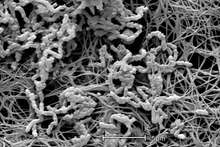Achromobacter
| Achromobacter | |
|---|---|
 | |
| Achromobacter xylosoxidans | |
| Scientific classification | |
| Kingdom: | Bacteria |
| Phylum: | Proteobacteria |
| Class: | Betaproteobacteria |
| Order: | Burkholderiales |
| Family: | Alcaligenaceae |
| Genus: | Achromobacter Yabuuchi and Yano 1981 |
| Type species | |
| Achromobacter xylosoxidans | |
| Species | |
|
A. arsenitoxydans | |
Achromobacter is a genus of bacteria, included in the family Alcaligenaceae in the order Burkholderiales. The cells are Gram-negative straight rods and are motile by using one to 20 peritrichous flagella. They are strictly aerobic and are found in water (fresh and marine) and soils.[1] They have also been identified as a contaminant in laboratory cell cultures.[2] They have been identified as opportunistic human pathogens in people with certain immunosuppressive conditions such as cystic fibrosis, cancer and kidney failure.[3]
References
- ↑ Garrity, George M.; Brenner, Don J.; Krieg, Noel R.; Staley, James T. (eds.) (2005). Bergey's Manual of Systematic Bacteriology, Volume Two: The Proteobacteria, Part C: The Alpha-, Beta-, Delta-, and Epsilonproteobacteria. New York: Springer. ISBN 978-0-387-24145-6.
- ↑ Gray, JS; Birmingham, JM; Fenton, JI (2010). "Got black swimming dots in your cell culture? Identification of Achromobacter as a novel cell culture contaminant". Biologicals : journal of the International Association of Biological Standardization. 38 (2): 273–277. doi:10.1016/j.biologicals.2009.09.006. PMC 2849847
 . PMID 19926304.
. PMID 19926304. - ↑ Swenson, Colin E.; Sadikot, Ruxana T. (2015-02-01). "Achromobacter Respiratory Infections". Annals of the American Thoracic Society. 12 (2): 252–258. doi:10.1513/AnnalsATS.201406-288FR. ISSN 2329-6933.
This article is issued from Wikipedia - version of the 4/12/2016. The text is available under the Creative Commons Attribution/Share Alike but additional terms may apply for the media files.